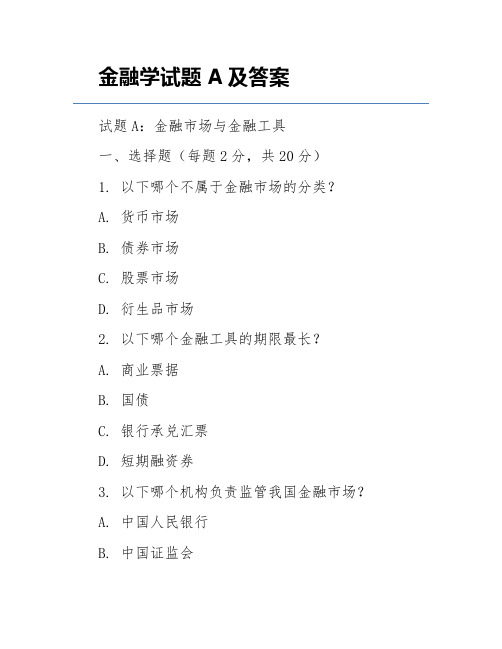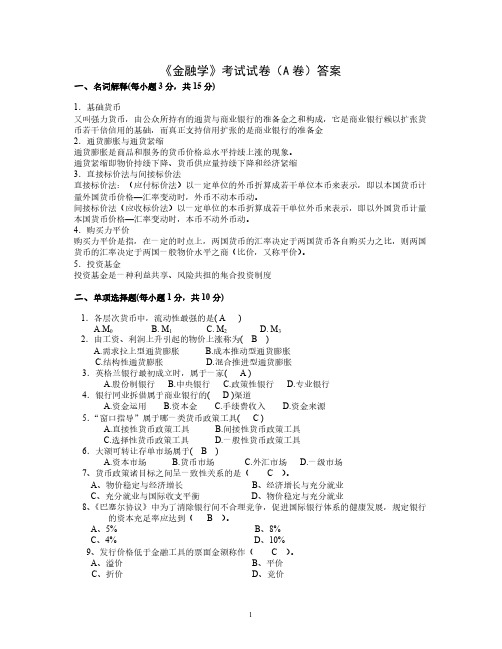(完整版)金融学试题A卷
金融学试题A及答案

金融学试题A及答案试题A:金融市场与金融工具一、选择题(每题2分,共20分)1. 以下哪个不属于金融市场的分类?A. 货币市场B. 债券市场C. 股票市场D. 衍生品市场2. 以下哪个金融工具的期限最长?A. 商业票据B. 国债C. 银行承兑汇票D. 短期融资券3. 以下哪个机构负责监管我国金融市场?A. 中国人民银行B. 中国证监会C. 中国银保监会D. 中国国债登记结算有限责任公司4. 以下哪个指标反映的是金融市场的流动性?A. 利率B. 汇率C. 波动性D. 换手率5. 以下哪个金融工具属于衍生品市场?A. 股票B. 债券C. 远期合约D. 基金二、简答题(每题10分,共30分)1. 请简要介绍金融市场的功能。
2. 请简要阐述金融市场的分类及其特点。
3. 请简要介绍金融工具的主要类型及其作用。
三、论述题(共40分)1. 请论述我国金融市场的发展现状及其挑战,并提出相应的政策建议。
答案:一、选择题1. D2. B3. A4. D5. C二、简答题1. 金融市场的功能主要包括:资源配置、风险分散、期限转换、信息传递和宏观调控。
2. 金融市场的分类及其特点如下:A. 货币市场:期限短,流动性高,风险低,主要满足短期资金需求。
B. 债券市场:期限较长,流动性较高,风险相对较低,主要用于政府和企业筹集长期资金。
C. 股票市场:期限不定,流动性较高,风险较高,主要用于企业融资和投资者投资。
D. 衍生品市场:以金融工具为基础,通过衍生出新的金融产品进行交易,风险较高,主要用于风险管理和投资。
3. 金融工具的主要类型及其作用如下:A. 股票:企业融资,投资者投资,分享企业利润。
B. 债券:政府、企业融资,投资者投资,固定收益。
C. 货币市场工具:短期融资,满足企业短期资金需求,如商业票据、银行承兑汇票等。
D. 衍生品:风险管理,投资,如远期合约、期货、期权等。
三、论述题1. 我国金融市场经过改革开放以来,取得了显著的发展成果,市场规模不断扩大,金融工具日益丰富,金融市场体系逐步完善。
2022年上海大学专业课《金融学》科目期末试卷A(有答案)

2022年上海大学专业课《金融学》科目期末试卷A(有答案)一、选择题1、当美元指数下降时,()。
A.美国出口竞争力提高,德国投资者投资于美元付息资产的本币收益率降低B.美国出口竞争力提高,德国投资者投资于美元付息资产的本币收益率上升C.美国出口竞争力降低,德国投资者投资于美元付息资产的本币收益率降低D.美国出口竞争力降低,德国投资者投资于美元付息资产的本币收益率上升2、假设一张票据面额为80000元,90天到期,月贴现率为5%。
,则该张票据的实付贴现额为()A.68000B.78000C.78800D.800003、“劣币驱逐良币”规律发生在()。
A.金银复本位制B.双本位制C.平行本位制D.破行本位制4、属于商业信用转化为银行信用的是()。
A.票据贴现B.股票质押贷款C.票据背书D.不动产质押贷款5、波浪理论考虑的因素主要包括三个方面,其中最重要的是股价的()。
A.相对位置B.比例C.形态D.时间6、个人获得住房贷款属于()。
A.商业信用B.消费信用C.国家信用D.补偿贸易7、股指期货的交割是通过什么形式完成的?()A.从不交割B.根据股票指数进行现金交割C.对指数内每一支股票交割一个单位D.对指数内每一支股票按照指数的加权比例分别交割8、在我国,收入变动与货币需求量变动之间的关系是()A.同方向B.反方向C.无任何直接关系D.A与B都可能9、信用的基本特征是()。
A.无条件的价值单方面让渡B.以偿还为条件的价值单方面转移C.无偿的赠与或援助D.平等的价值交换10、其他情况不变,若到期收益率票面利率,则债券将。
()A.高于、溢价出售B.等于、溢价出售C.高于、平价出售D.高于、折价出售11、关于马科维茨投资组合理论的假设条件,描述不正确的是()。
A.证券市场是有效的B.存在一种无风险资产,投资者可以不受限制地借入和贷出C.投资者都是风险规避的D.投资者在期望收益率和风险的基础上选择投资组合12、优先股的收益率经常低于债券的收益率,原因是()。
金融学期末试卷

金融学期末试卷金融学期末试卷(A卷)一、 1`=20`)?判断题 (20(错) 1、货币与财富是同一个概念。
(对) 2、金融资产的流动性越强,交易成本就越低,货币性就越强。
(错) 3、证券对于购买者来说是负债,对于发行者来说是资产。
(对) 4、一个只进行短期债务工具交易的金融市场被称为货币市场。
(对) 5、有价证券的价格与预期收益正相关,与市场利率负相关。
(错) 6、名义利率比实际利率能够更准确地反映借款的实际成本。
(错) 7、超额存款准备金对银行来说是无用的闲置资金,因而越少越好。
(对) 8、当你向某银行存入100元现金时,银行的负债增加100元。
(错) 9、中央银行的产生早于商业银行。
(错) 10、由于中央银行也经营存放汇等传统银行业务,所以它从根本上说与商业银行没有太大区别。
(错) 11、西方央行常采用调整法定准备金率来控制货币供应量。
(对) 12、非借入性基础货币来源于公开市场操作,因此央行可以完全控制。
(对) 13、假设其他条件不变,当一家银行从中央银行购买政府债券时,银行体系的准备金减少,基础货币减少。
(错) 14、货币供给与贴现贷款水平、非借入基础货币负相关。
(错)15、货币政策诸目标之间总是和谐统一的。
(错) 16、失业是坏事情,政府应尽量使失业率保持为零。
(对) 17、货币政策中介指标的相关性是强调它与政策目标而非政策工具之间的联系。
(错) 18、在任何时期央行可以同时选择货币供给和利率作为中介指标。
(错) 19、费雪方程式强调了人们对货币的主观需求因素。
(错) 20、弗里德曼与凯恩斯的货币需求理论的一个主要差异就在于前者认为利率是决定货币需求的重要因素。
二、单项选择题 1`=20`)?(20( ) 1、由于货币是一种计量单位,所以货币(B)。
A 增加了交易成本B 减少了需要制定的价格的数量C 没有利息D 限制专业化( ) 2、良好运作的金融市场会产生下列结果(D) A 引起通货膨胀B 消除对间接融资的需求C 引起金融危机D 使资本得到有效配置( ) 3、下列关于债务和股权工具的特征的表述哪一个是错误的?(B) A它们都是直接融资工具 B 它们都是短期融资工具C 它们都涉及到对发行者收入的一种要求权D 它们都能够为企业筹集资金( ) 4、如果你怀疑某公司1年后将破产,相比之下你对该公司发行金融工具的选择次序是( D ) A 普通股、公司债券、优先股 B 公司债券、普通股、优先股C 优先股、公司债券、普通股D 公司债券、优先股、普通股( ) 5、在下列哪种情况下你更愿意成为一个贷款人而非借款人?(B) A利率为9%而预期通货膨胀为7% B利率为4%而预期通货膨胀为1% C利率为13%而预期通货膨胀为15% D利率为25%而预期通货膨胀为50%( ) 6、在货币供给增加对利率影响的四个效应中,一般来说最初的效应是(B)。
2022年福建师范大学专业课《金融学》科目期末试卷A(有答案)

2022年福建师范大学专业课《金融学》科目期末试卷A(有答案)一、选择题1、一国货币升值对该国进出口的影响()。
A.出口增加,进口减少B.出口减少,进口增加C.出口增加,进口增加D.出口减少,进口减少2、假设一张票据面额为80000元,90天到期,月贴现率为5%。
,则该张票据的实付贴现额为()A.68000B.78000C.78800D.800003、一国货币制度的核心内容是()。
A.规定货币名称B.规定货币单位C.规定货币币材D.规定货币币值4、属于商业信用转化为银行信用的是()。
A.票据贴现B.股票质押贷款C.票据背书D.不动产质押贷款5、波浪理论考虑的因素主要包括三个方面,其中最重要的是股价的()。
A.相对位置B.比例C.形态D.时间6、19.下面观点正确的是()。
A.在通常情况下,资金时间价值是在既没有风险也没有通货膨胀条件下的社会平均利润率B.没有经营风险的企业也就没有财务风险;反之,没有财务风险的企业也就没有经营风险C.永续年金与其他年金一样,与递延期无关,所以计算方法和普通年金终值相同D.递延年金终值的大小,与递延期无关,所以计算方法和普通年金终值相同7、股指期货的交割是通过什么形式完成的?()A.从不交割B.根据股票指数进行现金交割C.对指数内每一支股票交割一个单位D.对指数内每一支股票按照指数的加权比例分别交割8、剑桥方程式重视的是货币的()。
A.媒介功能B.交易功能C.避险功能D.资产功能9、19.下面观点正确的是()。
A.在通常情况下,资金时间价值是在既没有风险也没有通货膨胀条件下的社会平均利润率B.没有经营风险的企业也就没有财务风险;反之,没有财务风险的企业也就没有经营风险C.永续年金与其他年金一样,与递延期无关,所以计算方法和普通年金终值相同D.递延年金终值的大小,与递延期无关,所以计算方法和普通年金终值相同10、信贷风险的借款者,常常是找寻贷款最积极,并且最可能得到贷款的人。
《金融学》试题及答案大全.docx

《金融学》试题及答案一、单项选择题1、目前,世界各国普遍使用的国际收支概念是建立在(B )基础上的。
A、收支B、交易C、现金D、贸易2、在国际收支平衡表中,借方记录的是(B )。
A、资产的增加和负债的增加B、资产的增加和负债的减少C、资产的减少和负债的增加D、资产的减少和负债的减少3、在一国的国际收支平衡表中,最基本、最重要的项目是(A )。
A、经常账户B、资本账户C、错误与遗漏D、官方储备4、经常账户中,最重要的项目是(A )。
A、贸易收支B、劳务收支C、投资收益D、单方面转移5、投资收益属于(A )。
A、经常账户B、资本账户C、错误与遗漏D、官方储备6、对国际收支平衡表进行分析,方法有很多。
对某国若干连续时期的国际收支平衡表进行分析的方法是(B )oA、静态分析法B、动态分析法C、比较分析法D、综合分析法7、周期性不平衡是由(D )造成的。
A、汇率的变动B、国民收入的增减C、经济结构不合理D、经济周期的更替8、收入性不平衡是由(B )造成的。
A、货币对内价值的变化B、国民收入的增减C、经济结构不合理D、经济周期的更替9、用(A )调节国际收支不平衡,常常与国内经济的发展发生冲突。
A、财政货币政策B、汇率政策C、直接管制D、外汇缓冲政策10、以下国际收支调节政策中(D )能起到迅速改善国际收支的作用。
A、财政政策B、货币政策C、汇率政策D、直接管制11、对于暂时性的国际收支不平衡,我们应用(B )使其恢复平衡。
A、汇率政策B、外汇缓冲政策C、货币政策D、财政政策12、我国的国际收支中,所占比重最大的是(A )A、贸易收支B、非贸易收支C、资本项目收支D、无偿转让13、目前,世界各国的国际储备中,最重要的组成部分是(B九A、黄金储备B、外汇储备C、特别提款权D、在国际货币基金组织(IMF)的储备头寸14、当今世界最主要的储备货币是(A )oA、美元B、英镑C、德马克D、法国法郎15、仅限于会员国政府之间和IMF与会员国之间使用的储备资产是(C )。
《金融学》考试试卷(A卷)答案-推荐下载

《金融学》考试试卷(A卷)答案一、名词解释(每小题3分,共15分)1.基础货币又叫强力货币,由公众所持有的通货与商业银行的准备金之和构成,它是商业银行赖以扩张货币若干倍信用的基础,而真正支持信用扩张的是商业银行的准备金2.通货膨胀与通货紧缩通货膨胀是商品和服务的货币价格总水平持续上涨的现象。
通货紧缩即物价持续下降、货币供应量持续下降和经济紧缩3.直接标价法与间接标价法直接标价法:(应付标价法)以一定单位的外币折算成若干单位本币来表示,即以本国货币计量外国货币价格—汇率变动时,外币不动本币动。
间接标价法(应收标价法)以一定单位的本币折算成若干单位外币来表示,即以外国货币计量本国货币价格—汇率变动时,本币不动外币动。
4.购买力平价购买力平价是指,在一定的时点上,两国货币的汇率决定于两国货币各自购买力之比,则两国货币的汇率决定于两国一般物价水平之商(比价,又称平价)。
5.投资基金投资基金是一种利益共享、风险共担的集合投资制度二、单项选择题(每小题1分,共10分)1.各层次货币中,流动性最强的是( A )A.M0B. M1C. M2D. M32.由工资、利润上升引起的物价上涨称为( B )A.需求拉上型通货膨胀B.成本推动型通货膨胀C.结构性通货膨胀D.混合推进型通货膨胀3.英格兰银行最初成立时,属于一家( A )A.股份制银行B.中央银行C.政策性银行D.专业银行4.银行同业拆借属于商业银行的( D )渠道A.资金运用B.资本金C.手续费收入D.资金来源5.“窗口指导”属于哪一类货币政策工具( C )A.直接性货币政策工具B.间接性货币政策工具C.选择性货币政策工具D.一般性货币政策工具6.大额可转让存单市场属于( B )A.资本市场B.货币市场C.外汇市场D.一级市场7、货币政策诸目标之间呈一致性关系的是( C )。
A、物价稳定与经济增长B、经济增长与充分就业C、充分就业与国际收支平衡D、物价稳定与充分就业8、《巴塞尔协议》中为了清除银行间不合理竞争,促进国际银行体系的健康发展,规定银行的资本充足率应达到( B )。
2024年中级经济师之中级经济师金融专业真题练习试卷A卷附答案

2024年中级经济师之中级经济师金融专业真题练习试卷A卷附答案单选题(共45题)1、在我国,负责监管互联网支付业务的机构是()A.中国银保监会B.国务院金融委C.中国证监会D.中国人民银行【答案】 D2、我国成立了具有主权财富基金性质的中国投资公司,这是()的举措。
A.为我国民营企业“走出去”铺路B.构建积极的外汇储备管理模式C.实施储汇于民政策D.遏制黄金储备过快增长【答案】 B3、投资银行进行股票承销时,在不同的承销方式中承担着不同的责任和风险。
在以下承销方式中,投资银行与发行人之间纯粹是代理关系,投资银行为推销证券而收取代理手续费的是()。
A.包销B.尽力推销C.混合推销D.余额包销【答案】 B4、国务院金融稳定发展委员会的基本职能是()A.集中制定金融业的法规制度和运行规则B.统监管我国金融市场和各个金融行业C.牵头履行货币政策和宏观审慎管理职责D.统筹协调金融稳定和改革发展重大问题【答案】 D5、以下资料选自2009年7月中国建筑股份有限公司首次公开发行A股的发行公告。
中国建筑首次公开发行不超过120亿股人民币普通股(A股)的申请已获中国证券监督管理委员会证监许可2009627号文核准。
本次发行的保荐人是中国国际金融有限公司。
本次发行采用网下向询价对象询价配售与网上资金申购发行相结合的方式进行,其中网下初始发行规模不超过48亿股,约占本次发行数量的40%;网上发行数量为本次发行总量减去网下最终发行量。
对网下发行采用询价制,分为初步询价和累计投标询价。
发行人及保荐人通过向询价对象和配售对象进行预路演和初步询价确定发行价格区间,在发行价格区间内通过向配售对象累计投标询价确定发行价格。
网上申购对象是持有上交所股票账户卡的自然人、法人及其他机构。
各地投资者可在指定的时间内通过与上交所联网的各证券交易网点,以发行价格区间上限和符合本公告规定的有效申购数量进行申购委托,并足额缴付申购款。
从公告中可知,我国目前对企业首次公开发行股票所采取的监管制度是()。
金融学本科A答案

2.答:(1)债券的名义收益率=10÷100×100%=10%(3分)
(2)债券的即期收益率=10÷90×100%=11%(3分)
(3)债券实际收益率=(10+10÷5)÷90×100%=13%(4分)
3.答:(1)用单利方法计算:S=2000万元×(1+7%×5)=2700万元(5分)
3.(1)2010-2014年这一阶段人民币总体呈升值态势,2014年-2016年人民币出现贬值趋势(3分);
(2)人民币贬值会导致中国商品的外币价格下降,提高外国对中国产品需求,有助于出口型企业增加商品出口,而进口型企业而言会导致进口商品的人民币价格上升,增加企业购买成本(4分);
(3)从消费成本来说,2010-2014这个阶段对出口留学、旅游人群来说更加有利。因为随着人民币升值,可以降低外国商品人民币价格,降低人们消费成本(3分)。
央行常规性货币政策工具有:
(1)公开市场业务:央行在证券市场买卖有价证券调节市场中货币量业务(2分);
(2)再贴现业务是指商业银行以未到期的商业票据向中央银行申请贴现取得融资的业务(2分);
(3)存款准备金业务:中央银行通过调整法定存款准备金以增加或减少商业银行的超额准备,从而影响货币供应量的一种政策措施(2分)。
大学2019-2020学年度第一学期
《金融学A》期末考试参考答案和评分标准(A卷,考试)
命题教师:审核人:年级专业:
一、单项选择(在备选答案中选出一个正确答案,并将其序号填在答题纸上的答题栏内。每题2分,共20分)
题号
1
2
3
4
5
6
7
- 1、下载文档前请自行甄别文档内容的完整性,平台不提供额外的编辑、内容补充、找答案等附加服务。
- 2、"仅部分预览"的文档,不可在线预览部分如存在完整性等问题,可反馈申请退款(可完整预览的文档不适用该条件!)。
- 3、如文档侵犯您的权益,请联系客服反馈,我们会尽快为您处理(人工客服工作时间:9:00-18:30)。
国际商学院2010-2011学年度第二学期《金融学》期末考试试卷(A)试作弊不授予学士学位。
”姓名学号专业成绩Single Choice Questions(2 points per question, 12 point maximum)pany X has a beta of 1.5. The risk-free interest rate is 6% per annum; and theexpected market premium is 10% per annum. What is Company X’s cost of equity?A: 9%; B: 12%; C: 15%; D: 21%.2.If the intrinsic value of a share of common stock is more than its market value,which of the followings is the most reasonable conclusion?A: The stock has a low level of riskB: The stock offers a high dividend payout ratio.C: The market is undervaluing the stock.D: The market value is always more than the intrinsic value.3.Which of the following statements on efficient market hypothesis is true:A: If a market is weak-form efficient, it must be semi-strong form efficient.B: If a market is semi-strong-form efficient, it must be weak-form efficient.C: If a market is strong-form inefficient, it must be semi-strong-form inefficient D: If a market is strong-form efficient, it could be semi-strong-form inefficient. 4.Which of the followings is a way of avoiding losses through hedging?A: Purchase a put option on a stock you do own.B: Lease a car with the option to purchase it in three years.C: Enter into a swap contract to exchange fixed exchange interest payments forfloating-rate payment because you have floating-rate assets.D: pay a reservation fee to insure that you can purchase a flight ticket for not more than $200.5.Which of the flowing features of insurance contracts is to create incentives forinsured parties to control small loss, but not large loss?A: exclusions; B: copayments; C: caps; D: deductibles.6.In a company with dispersed ownership, shares of the company are owned bymany small investors, each shareholder may not have the incentive to monitor management, because the cost of monitoring exceeds the benefit from monitoring.This is calledA: the free-rider problem; B: the free cash flow problem;D: the moral hazard problem; D: the adverse selection problem.Calculation questions (本部分每题12分,要求从中选4题应答,如6题都应答,则取得较高分的4题的得分将作为本部分的得分计入总成绩,即本部分的最高分为48分,多答不扣分)Group I:1.Mia Company and Satu Company are identical, differing only in their capitalstructures. Mia is an unlevered firm issuing only stocks whereas Satu issues stocks and bonds. Each firm has an annual EBIT of $15 million forever. There is not tax for either company. Mia pays out all its yearly earnings in the form of dividends and has 1 million shares outstanding. Its market capitalization rate is 12%. Satu is identical except that 40% of its market value is in bonds and has 500,000 shares outstanding. Satu’s bonds are default-free perpetuity bonds with a coupon rate of 10% per year. The risk-free interest rate is 10%.A: What is the value per share of Mia and Satu, respectively?B: If the market price of Satu’s stocks is $160 per share, is there an arbitrage opportunity? If there is an arbitrage opportunity, how would you take advantage of such opportunity? (show your detailed arbitraging strategy)2.You are considering the purchase of an apartment with a total price of $1 million.A bank offers you a 30-year mortgage for 70% of the total price of the apartmentwith equal installment payment at the end of each month. The nominal (stated) annual interest rate is 7.2%.A: Assuming that your monthly salary is $6,000 now, and expected to grow 5% annually. What percentage is your monthly salary to your monthly mortgage payment ten year from now? (Note: please show the calculation detail)B: If you can afford to pay $6,000 per month, how many years would it take to pay off the loan?3.You are evaluating a new project for your firm. The project requires cashinvestment of $1.1 million at the start, and a $100,000 maintaining fee each year during the project’s life. After-tax cash inflows of $400,000, $600,000, $600,000, and $500,000 are expected in year 1 through year 4, respectively. All the above cash inflows and outflows are in nominal term. After year 4, the project will be terminated with zero salvage value. The real required rate of return for the project is 10%, and the inflation rate for the next four year is expected to be 2% annually.What are the payback period, net present value, and the nominal internal rate of return of the project?4.You are currently 20 year old, plans to start to work two year from now (at age 22).You expect to retire at age 60 and live to age 80. Your labor income is $50,000 per year during your working years, and you intend to maintain a constant level of real consumption spending over the next 60 years. Assume not tax, no growth in real salary, and a real interest rate of 3% per year.A: What is the value of your human capital now (at age 20)?B: What will be your permanent income at age 30?5.Suppose that the term structure of riskless interest rates is as flows:A: What should be the market price of a 3-year 6% riskless coupon bond with annual coupon payment and $1,000 face value?B: A 3-year 10% coupon bond (with annual coupon and $1,000 face value) issued by Sami Company is rated BAA, and is currently trading at a market price of $992.Aside from its risk of default, the Sami bond has not other financially significant features. How much should an investor be willing to pay for a guarantee against Sami’s defaulting on this bond? (Hind: with the guarantee, the investor can be assured of getting his promised coupon and principal.)6.The Matti Company is an all-equity financed firm with a market capitalization rateof 10% per year. Its latest EPS (earnings per share) was $5. The company paid out 20% of its earnings in cash dividend and is expected to maintain this 20% payout ratio in the next five years. The rate of return on new investment is expected to be 15% annually in the next five years. Starting 6 year from now, the firm’s rate of return on new investment is expected to fall to 10%, and the company is expected to start paying out 50% of its earnings in cash dividend, which it will continue to do forever after.A: What is the intrinsic value per share of Matti?B: What is the market price per share of Matti one year from now (assuming its market price is equal to its intrinsic value)?Answer and explanation questions (本部分每题10分,要求从中选4题应答,如6题都应答,则取得较高分的4题的得分将作为本部分的得分计入总成绩,即本部分的最高分为40分,多答不扣分)1.What is the efficient portfolio frontier in portfolio selection? How to construct theoptimal portfolio (the best risk-reward trade-off line) with many risky assets and the riskless asset? (you might use figures for assistance)2.What is the market portfolio? Why is the market portfolio the optimalcombination of risky assets when the market is in equilibrium?3.Why might debt be used to alleviate the free cash flow problem betweenmanagement and shareholders?4.What is an indexing investment strategy? What is the main logic behind indexing?What are the advantages of indexing investment as compared to active investment?5.Should the average required rate of return be higher or lower in economicexpansion period than that in economic recession period? Why?6.In general, there are two kinds of arbitrage strategies, what are they? Give oneexample for each strategy.。
